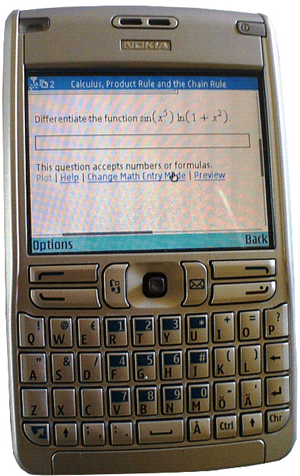Learning to master certain routine tasks, such as computing with fractions, solving equations and computing limits, derivatives and integrals, forms a large part of mathematics education in secondary and early tertiary education. Training these skills produces the computational fluency and execution of procedures required, together with conceptual understanding, to support efficient problem solving. Drills and formative assessments can be delivered especially well by automatic learning systems. Computer-assisted assessment is based on advanced algorithmic exercises that are newly generated each time they are invoked. This is the most valuable aspect of e-learning materials. The WebALT project 2005-2006 (EDC-22253) developed a grammar that is able to encode these algorithmic problems so that they can be generated automatically in several European languages. This is made possible by employing Web standards (to represent the algorithmic exercises) in combination with advanced computational linguistic tools (to produce the various verbalizations). This technology contributes both to the preservation of the linguistic diversity and richness in Europe and to the creation of a pool of standardized tests aligned with the Bologna process. WebALT multilingual exercises are language-independent and can be adopted across borders. This multiplies the value of the content many times over.
The algorithmic problems together with high-quality supporting materials empower instructors to teach large numbers of students with the same effort needed to teach just one small group. Grading of homework, quizzes and examinations becomes automatic, available to students any time, anywhere. Even lectures can be delivered automatically as podcasts, turning mobile devices to portable lecture halls. The WebALT eContent was coordinated by the University of Helsinki. The Technical University of Catalonia (UPC), the Technical University of Eindhoven and the University of Cologne were partners in the project. Maths for More was the commercial partner associated to UPC. Currently the partners are members of the Joining Educational Mathematics thematic network (JEM), whose aim is to coordinate content-enrichment activities in the area of e-learning in mathematics, to maintain standards and to deliver synoptic high-quality user information and support pages.

The kind of technology, services and content showcased by the WebALT project has the potential to industrialize instruction. Proper use of automation will make the delivery of education much more effective without compromising its quality. The recent final report of the National Mathematics Advisory Panel highlighted the importance of mathematics in the future and noted that high-quality computer-assisted instruction (CAI) drill and practice, implemented with fidelity, be considered as a useful tool in developing students' automaticity (ie fast, accurate, and effortless performance on computation), freeing working memory so that attention can be directed to the more complicated aspects of complex tasks. This is what the WebALT project has begun to do in Europe. The showcases built and the pilot projects run at schools clearly demonstrate the potential of proper and innovative use of technology in instruction.
Following the US example, the European Union must continue its efforts to educate educators to take advantage of the benefits of technology and new media. The inertia of the academia is, at times, overwhelming. To effect a change, decisive action and further resources are needed. This investment will quickly produce returns, and is absolutely necessary to guarantee the competitiveness of Europe in the global marketplace.
Links:
http://jem-thematic.net
http://webalt.com
http://www.ed.gov/about/bdscomm/list/mathpanel
Please contact:
Mika Seppälä
E-mail: mika.seppala![]() webalt.net
webalt.net










